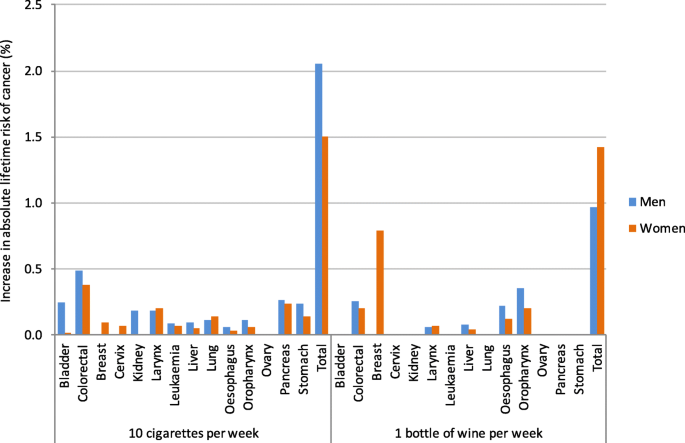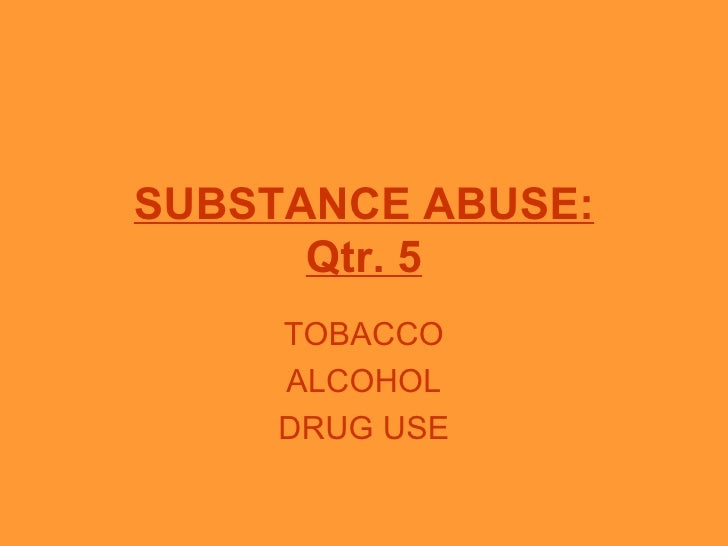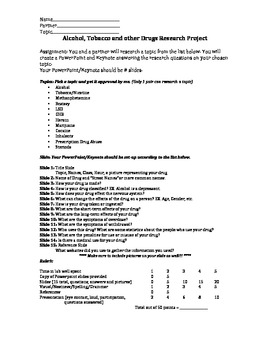- About alcohol, tobacco, and other drugs so they may make responsible and informed decisions throughout their lifetime. The Comprehensive Health Education and Physical Education Framework addresses only the instructional component of a comprehensive alcohol, tobacco, and other drug pr e-vention program. Substance abuse occurs in every community.
- Start studying Health 5.11 Unit test: Alcohol, Tobacco, and Other Drugs. Learn vocabulary, terms, and more with flashcards, games, and other study tools.

Unit 5: Tobacco, Drug and Alcohol Prevention 2 (OTC) dru inhalants, and anaboli Essential Knowledge § Drug use is the correct use of legal drugs. § Drug misuse is the incorrect use of prescription or over the counter gs. § Drug abuse is the intentional use of a drug without medical or health reasons. Other Drugs Tobacco General Alcohol, Tobacco, and Other Drugs/Substance Use Resources. Above the Influence Sponsored by the Office of National Drug Control Policy. Comprehensive database for information on numerous substances, including effects, statistics, prevention and treatment, crime, and personal stories. Alcohol’s first pit stop may be the stomach, but it sure doesn’t stay there! Alcohol moves through the body, entering various organs and affecting how they function. Once alcohol enters a person’s brain, it can cause changes in both mood and behavior. First, do some research to find out about the path that alcohol takes once it enters the.
Frequently Asked QuestionsExpand All
During pregnancy, women should not use tobacco, alcohol, marijuana, illegal drugs, or prescription medications for nonmedical reasons. Avoiding these substances and getting regular are important to having a healthy pregnancy and a healthy baby. Counseling and treatment are available if you have hard time quitting unhealthy substances on your own.
When a woman smokes cigarettes during pregnancy, her is exposed to many harmful chemicals. Nicotine is one of 4,000 chemicals that can pass from a pregnant woman to her fetus.
Nicotine damages a fetus’s brain and lungs. This damage is permanent. Nicotine also causes blood vessels to narrow, so less and fewer reach the fetus.
Smoking during pregnancy increases the risk of birth. Babies that are born too early may not be fully developed. They may be born with serious health problems. Some health problems, like , can last a lifetime. Other problems, such as learning disabilities, may appear later in childhood or even in adulthood.
Babies born to women who smoked during pregnancy are at risk of other problems, including:
- such as cleft lip (a split in the upper lip)
- Higher rates of colic (uncontrollable crying and irritability)
- Childhood asthma and obesity
Ideally, you should stop smoking before pregnancy. But stopping smoking during pregnancy is better than not stopping at all. If you are smoking when you find out you are pregnant, you should stop. See the Resources section for how to get help with quitting.
Yes. Secondhand smoke is other people’s smoke that you inhale. Breathing secondhand smoke during pregnancy increases the risk of having a low-birth-weight baby. Also, babies who are exposed to secondhand smoke have an increased risk of SIDS. They are more likely to have asthma attacks and ear infections. Take steps to avoid secondhand smoke at home and work.
E-cigarettes are powered by a battery. They contain nicotine, plus flavoring and a propellant that may not be safe for you or your fetus. Avoid e-cigarettes—or “vaping”—during pregnancy.
Some people prefer to chew tobacco rather than smoke it. The products used are called smokeless tobacco. Smokeless tobacco also contains nicotine that can be passed to a fetus during pregnancy. These products also should be avoided.
Alcohol can interfere with the normal growth of a fetus and cause birth defects. When a woman drinks during pregnancy, her fetus can develop lifelong problems. It is safest not to drink at all while you are pregnant.
is the most severe disorder that can be caused by drinking during pregnancy. FAS can cause:
- Growth problems
- Mental disability
- Behavioral problems
- Abnormal facial features
FAS is most likely to occur in infants whose mothers drink heavily throughout pregnancy. But alcohol-related problems also can occur with lesser amounts of alcohol use.
If it is hard for you to stop drinking, help is available (see the Resources section). Talk with your or other about your drinking habits. If you are dependent on alcohol, you may need specialized counseling and medical care.
Marijuana used during pregnancy is associated with attention and behavioral problems in children. Some studies suggest that marijuana use may increase the risk of and the risk that babies will be smaller than babies who are not exposed to marijuana before birth. For these reasons, you should not use marijuana in any form during pregnancy.
The American College of Obstetricians and Gynecologists (ACOG) recommends that pregnant women and those planning to get pregnant stop using medical marijuana. You and your ob-gyn or other obstetric care provider can discuss other treatments that will be safer for your fetus.
Drug use can mean using illegal drugs, such as heroin, cocaine, and methamphetamines (“meth”). It also can mean using prescription medication in a way your doctor did not order, such as taking pain medication for the “high” even when you no longer have pain. Your ob-gyn or other obstetric care provider may ask about your use of drugs throughout your pregnancy.
The early stage of pregnancy is the time when main body parts of the fetus form. Using illegal drugs or misusing prescription medication early in pregnancy can cause birth defects and .
During the later weeks of pregnancy, illegal drug use can interfere with the growth of the fetus and cause preterm birth and fetal death. Babies born to women who used illegal drugs during pregnancy may need specialized care after birth. These babies have an increased risk of long-term medical and behavioral problems.
are a type of medication that relieves pain. They also release chemicals in the brain that have a calming effect. Doctors may prescribe opioids for people who have had surgery, dental work, or an injury. Prescribed opioids include oxycodone, hydromorphone, hydrocodone, fentanyl, and codeine.
When taken under a doctor’s care, opioids are safe for both you and your fetus. If you are prescribed an opioid before or during pregnancy, you and your ob-gyn or other obstetric care provider should discuss the risks and benefits of this treatment. It is important to take the medication only as prescribed.
Most people who use a prescription opioid have no trouble stopping their use, but some people develop an addiction. This is called . People with this disorder may look for other ways to get the drug when their prescription runs out. They may go from doctor to doctor to have new prescriptions written for them, or they may use illegal opioids.
Misusing opioids during pregnancy can increase the risk of serious , including:
- Placenta problems
- Fetal growth problems
- Preterm birth
- Stillbirth
The best treatment for opioid use disorder during pregnancy is opioid replacement medication, behavioral therapy, and counseling. The medications that are given are long-acting opioids. This means that they stay active in the body for a long time. These opioids, called methadone and buprenorphine, reduce cravings but do not cause the pleasant feelings that other opioids cause.
Yes. Treatment with either methadone or buprenorphine makes it more likely that the fetus will grow normally and not be born too early. Based on many years of research, neither medicine has been found to cause birth defects.
Some babies born to women taking opioids, including methadone or buprenorphine taken for treatment of opioid use disorder, can have temporary withdrawal symptoms. This is called . Symptoms of NAS can include shaking and tremors, poor feeding or sucking, crying, fever, diarrhea, vomiting, and sleep problems.
Not all babies will go through withdrawal. For those that do, some things can be done to make babies with NAS feel better, including swaddling, breastfeeding, and skin-to-skin contact. Some babies also may be given medication. A baby may need to stay in the for a few days or weeks while taking the medication. NAS causes no known lasting physical or intellectual problems for babies.
Birth Defects: Physical problems that are present at birth
Cerebral Palsy: A disorder of the nervous system that affects movement, posture, and coordination. This disorder is present at birth.
Complications: Diseases or conditions that happen as a result of another disease or condition. An example is pneumonia that occurs as a result of the flu. A complication also can occur as a result of a condition, such as pregnancy. An example of a pregnancy complication is preterm labor.
Fetal Alcohol Syndrome (FAS): The most severe disorder resulting from alcohol use during pregnancy. FAS can cause abnormalities in brain development, physical growth, and facial features of a baby or child.
Fetus: The stage of human development beyond 8 completed weeks after fertilization.
Low Birth Weight: Weighing less than 5 ½ pounds (2,500 grams) at birth.
Miscarriage: Loss of a pregnancy that is in the uterus.
Neonatal Abstinence Syndrome (NAS): A group of problems that happen to a newborn who was exposed to addictive substances before birth. A common cause of NAS is opioid use disorder.
Neonatal Intensive Care Unit (NICU): A special part of a hospital in which sick newborns receive medical care.
Nutrients: Nourishing substances found through food, such as vitamins and minerals.
Obstetric Care Provider: A health care professional who cares for a woman during pregnancy, labor, and delivery. These professionals include obstetrician–gynecologists (ob-gyns), certified nurse–midwives (CNMs), maternal– fetal medicine specialists (MFMs), and family practice doctors with experience in maternal care.
Obstetrician–Gynecologist (Ob-Gyn): A doctor with special training and education in women’s health.
Opioid: Drugs that decreases the ability to feel pain.
Opioid Use Disorder: A treatable disease that can be caused by frequent opioid use. It is sometimes called opioid addiction.
Oxygen: An element that we breathe in to sustain life.
Prenatal Care: A program of care for a pregnant woman before the birth of her baby.
Preterm: Less than 37 weeks of pregnancy.
Stillbirth: Birth of a dead fetus.
Sudden Infant Death Syndrome (SIDS): The unexpected death of an infant in which the cause is unknown.
Resources
Counseling and treatment are available to help you stop using unhealthy substances. These organizations offer support and guidance:
- Quit Smoking Hotline
1-800-QUIT-NOW (784-8669) - American Lung Association
1-800-586-4872
http://www.lung.org - Alcoholics Anonymous
212-870-3400
http://www.aa.org - Narcotics Anonymous
818-773-9999
http://www.na.org - Substance Abuse and Mental Health Services Administration (SAMHSA)
24-hour Treatment Referral Line: 1-800-662-HELP (4357)
http://www.samhsa.gov
Article continues below
Advertisement

ACOG does not endorse companies or products.

If you have further questions, contact your ob-gyn.
Drugs Tobacco And Alcohol Article
FAQ170

Published: June 2020

Drug Alcohol And Tobacco Education
Last reviewed: June 2020
Unit 5 Tobacco Alcohol And Drugs On The Body
Copyright 2021 by the American College of Obstetricians and Gynecologists. All rights reserved. Read copyright and permissions information.
Unit 5 Tobacco Alcohol And Drugs Classification
This information is designed as an educational aid for the public. It offers current information and opinions related to women's health. It is not intended as a statement of the standard of care. It does not explain all of the proper treatments or methods of care. It is not a substitute for the advice of a physician. Read ACOG’s complete disclaimer.
Navy Alcohol Drugs Tobacco Training
Unit 6: Alcohol and Drugs
|
